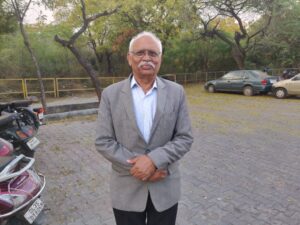Prof. B.S. Waghmare
Retired Professor,
Centre for the Study of Law
and Governance at Jawaharlal Nehru University

Shivam Mogha
Research Scholar in Sociology,
Jawaharlal Nehru University

The Supreme Court of India Judgment, on August 1, 2024, in The State of Punjab and Ors. Vs Davinder Singh and Ors., on the sub-classification of reservations, embodies the vision of social jurisprudence. It is a noteworthy development in Indian jurisprudence, especially in social justice. The judgment provides social jurisprudence using constitutional methods and ensures that social justice reaches the most neglected and deprived sections (which includes a majority of Dalit castes) among Dalits. The idea of sub-classification also aligns with B.R. Ambedkar’s principles of fraternity and Maitri, emphasising the need for cooperation and mutual respect among Schedule Castes (SC). However, the overreaching exercise of the judgment, reflected in the comments on the varna system and creamy layer, is uncalled for.
Social justice and B.R. Ambedkar’s struggle
B.R. Ambedkar struggled all his life to ensure social and civil justice for the most oppressed sections. He also sought to secure separate cultural rights for former untouchables. Yet, these were often met with inadequate responses and resistance from the prevailing Hindu caste order. While reflecting on the Indian social structure. Ambedkar highlights how every jati occupies a distinct position on the social ladder. It draws attention to the nuances of internal divisions within the caste order. A newspaper of his times reported Ambedkar’s response to “the welcome addresses by three scheduled castes” organisations after the resolutions were disposed of at the Scheduled Castes’ Conference, held at Cawnpore on January 31, 1944… He (Ambedkar) urged that they (Scheduled Castes) must realise their responsibility to wipe out internal divisions among the Scheduled Castes when they demanded of other’s removal of Untouchability”.
His contribution to social justice goes beyond theoretical exercise.
His practical measures to dismantle the caste hierarchy have been remarkable. He led movements such as the Mahad Satyagraha and the Kalaram temple entry movement, that highlighted the ritual discrimination faced by Dalits. Despite such efforts, Brahminical forces often undermined his quest for a just society. Yet, amid such challenges, Ambedkar’s perseverance in fighting for justice in a hierarchical society illustrates his deep commitment.
In a media interview, Shahu Patole, who wrote a book on Dalit food in Marathawada, observed that different jatis experience varying degrees of discrimination. While talking about his experiences in the village, he says that “Mang was considered the lowest, above them were the Mahars. Mang and Mahars were deemed untouchable by Chamars, and the rest of villages did not touch these communities”. This affirms the existence of graded inequality, which Ambedkar also asserted in his sociological treatise.
These suggest the need for a more nuanced approach to social justice, which the Court’s sub-classification judgment seeks to address – at least partly. This judgment can be interpreted through Ambedkar’s social justice ideals. It underlines the existence of different lived realities of numerous jatis that experience levels of deprivation and discrimination. Thus, the judgment aims to mitigate the inequality within the SC community by addressing such heterogeneity. This is precisely where the judgment demonstrates the idea of social jurisprudence to the core because it takes into account the different sociological realities of every jati.
Criticism from within
Even though it has still to be implemented in various States, the sub-classification decision has drawn criticism from some Dalit communities, especially from leading segments of Dalits who feel their political leverage might diminish. This fear results from the assumption that the sub-classification judgment might fragment the Dalit constituency and weaken the collective Dalit movement. Sadly, this argument also assumes that there is a single Dalit movement. In contrast, many sociological accounts show that there have always been different shades of the Dalit politics, as reflected in the many Dalit movements.
However, this argument by the leading segments among Dalits discounts the underlying Ambedkarite consciousness of various-shades of Dalit politics. In this context, 30 years of the Madiga Dandora movement are misrepresented as being detached from the sphere of an Ambedkarite consciousness.
Even the movements and mobilisations of the Mang caste in Maharashtra have Ambedkar’s picture alongside that of Lokshahir Annabhau Sathe among other leaders. This symbolises how every caste’s issue may be different when they deal with other castes but are unified in the larger Ambedekarite idea of social justice.
The Bharat bandh called for by specific Dalit organisations in North India was a misstep that could affect the collective identity and mobilisation of Dalit castes. While the sub-classification debate in North India faces criticism, the situation is a bit different in South India. There, the discussion about sub-classification among Dalits has largely been resolved, with most Dalit organisations supporting the demand for sub-categorisation among SCs.
The criticism from North Indian Dalit organisations – they argue that the judgment might create divisions within the Dalit movement – reflects a misunderstanding of the existing social structure among Dalits.
Supporting the sub-classification movement and embracing its potential benefits for enhancing social justice politics at the jati level would be a mature approach. More importantly, Sub-classification could strengthen the collective identity of SCs, furthering the Ambedkarisation process by including those on the margins. It would also align with the principles of equitable representation articulated by leaders such as Manayavar Kanshiram, who advocated Jiski Jitni Sankhya Bhari Uski Utni Hissedari, an ideal of representation based on numerical strength.
Reflection of a long struggle, realities
The leading segments among SCs must avoid demeaning the relentless struggles of the marginalised communities, such as the Valmikis and Musahars in North India, and the Madigas and Arunthathiyars in the South. This is because the judgment is not an imposition from above but a reflection of years of grass-root activism and demands for sub-categorisation. It is a testament to the ongoing struggle for justice led by organisations such as the Madiga Reservation Porata Samithi (MRPS), conferences of the Mang community in Maharashtra, and the Valmiki movements in North India.
There is much concern about its execution.
Though history also tells us about the success of the sub-classification model in Punjab and Haryana before the Chinnaiah Judgement in 2004, which is an example of how such measures can work in practice, despite criticism from some quarters. It is essential to recognise that the judgement is grounded in a historical struggle for equitable representation and justice.
The judges’ affirmation was essential because it established that the SC category is not homogeneous but consists of distinct jatis with varying needs and challenges. The trajectories of jatis go beyond the idea of caste essentialism, and their behaviours are also in response to other jatis. On the other hand, recognition of the sociological fact that the SC community represents a union of jatis within their structures is a significant step towards addressing the nuanced needs of each group. The assumption that the SC is one homogeneous group fails in the face of prohibitions on inter marriage even within the community. These are hard sociological facts that one must not deny.
Finally, while challenges remain about accepting this judgment, it is essential to recognise its potential to enhance social justice to the core and promote equitable representation of all Dalit castes. Embracing this judgment with the spirit of fraternity, as Ambedkar envisioned, will be crucial in achieving a more just and inclusive society that ultimately leads to the democratisation of the reservation system. While upholding Dalit civility and addressing the creamy layer issue with due seriousness, the collective Ambedkarite movement must also prevent political parties from exploiting this judgment for their gains.
In addition, the movement should broaden its focus beyond traditional reservation policies. Key initiatives should include advocating the extension of reservation policies to the private sector and pursuing land redistribution. These steps are crucial for advancing representation and securing material benefits for all Dalits communities.
Courtesy: ‘The Hindu’





